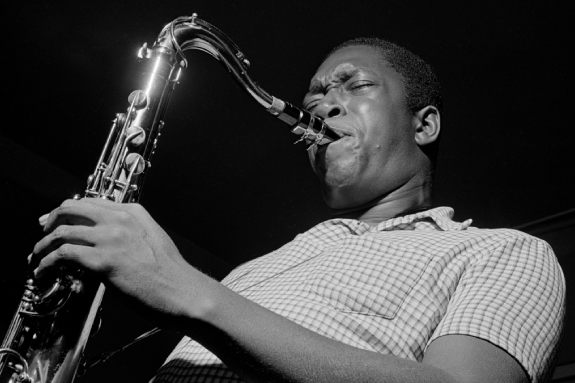John Coltrane – A Complete Biography
Introduction
John William Coltrane (1926–1967) was an American jazz saxophonist, bandleader, and composer whose innovations in harmony, rhythm, and spiritual expression reshaped modern music. Rising from bebop roots to modal and free-jazz frontiers, he forged a language of breathtaking technical command (“sheets of sound”) and fervent lyricism. His classic albums—Blue Train, Giant Steps, My Favorite Things, and A Love Supreme—remain touchstones for players and listeners alike. Posthumously honored with a Pulitzer Prize citation and a Grammy Lifetime Achievement Award, Coltrane’s influence radiates across genres and generations.

Childhood
Coltrane was born on September 23, 1926, in Hamlet, North Carolina, and grew up in nearby High Point. Music coursed through his family life, with church and community shaping his early sensibilities. He began on E-flat alto horn and clarinet before moving to alto sax; the deaths of his father and grandfather around his twelfth year deepened his introspective nature and connection to music. In his teens he practiced obsessively, absorbing swing and early bebop recordings.
Youth
During World War II, Coltrane served in the U.S. Navy (1945–46), performing in the base band at Pearl Harbor—his first sustained professional experience. After the war he settled in Philadelphia, studying at Granoff Studios and the Ornstein School of Music while playing local gigs. By 1949 he was recording with Dizzy Gillespie’s orchestra; work with Eddie “Cleanhead” Vinson and Johnny Hodges followed, all of which strengthened his tenor voice and professional discipline.
Adulthood
In the mid-1950s Coltrane joined and periodically rejoined Miles Davis, contributing to pivotal sessions including Milestones and Kind of Blue. A crucial 1957 stint with Thelonious Monk at New York’s Five Spot supercharged his harmonic daring and helped catalyze the torrential, arpeggio-rich style later nicknamed “sheets of sound.” By 1960 he launched his own groups, eventually forming the “Classic Quartet” with McCoy Tyner (piano), Jimmy Garrison (bass), and Elvin Jones (drums). With them he explored modal forms, extended vamps, and hypnotic drones, later pushing into freer, more ecstatic improvisation that incorporated spiritual and non-Western influences. In the mid-1960s his ensemble expanded at times, and his music embraced raw timbres and multiphonics that would profoundly shape avant-garde jazz.
Major Compositions
Coltrane’s recorded legacy maps the arc of modern jazz:
- Blue Train (1957) distilled hard-bop vigor with striking compositional clarity.
- Giant Steps (1960) introduced the famously cyclical “Coltrane changes,” a benchmark in harmonic athleticism.
- My Favorite Things (1960) transformed a Broadway waltz into a modal mantra on soprano sax, signaling a broader modal and world-music outlook and changing American music’s listening habits.
- A Love Supreme (1965) stands as his spiritual manifesto—a four-part suite (“Acknowledgement,” “Resolution,” “Pursuance,” “Psalm”) that fused prayer and improvisation and became one of jazz’s most revered albums.
Coltrane’s late period documents his leap into boundless form: Ascension (1965), Meditations (1966), and the posthumous Expression (1967) chart his final explorations. Newly unearthed archival issues—such as A Love Supreme: Live in Seattle (recorded 1965; released decades later)—underscore the continuing vitality and scholarship around his oeuvre.
Death
Coltrane died on July 17, 1967, at Huntington Hospital on Long Island, New York, from liver cancer. He was just 40. The jazz world was largely unaware of his illness; Miles Davis later remarked that the news shocked everyone. Four days later, mourners gathered at St. Peter’s Lutheran Church in Manhattan, where the Albert Ayler Quartet opened and the Ornette Coleman Quartet closed the service—an apt testament to Coltrane’s bridge between tradition and the avant-garde. He is buried at Pinelawn Memorial Park in Farmingdale, New York.
Conclusion
John Coltrane’s journey—from disciplined craftsman to spiritual seeker—rewrote the possibilities of jazz. His relentless practice, ethical seriousness, and openness to global sounds yielded music that feels both rigorously constructed and wildly free. Decades after his passing, honors continue to accrue, scholarship deepens, and newly discovered recordings refocus our ears. Yet his core message remains legible: sound as a path to truth. For listeners and musicians, Coltrane still points forward.

Comments are closed